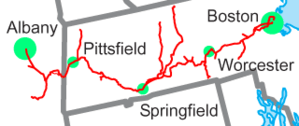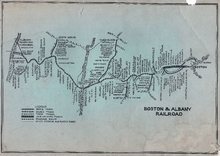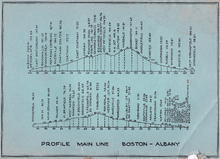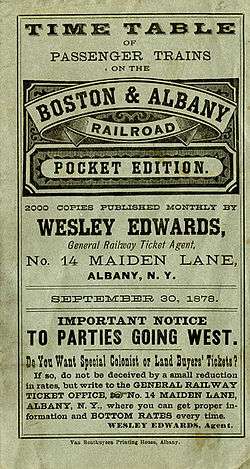Boston and Albany Railroad
 | |
 | |
| Reporting mark | B&A |
|---|---|
| Locale | Massachusetts and eastern New York |
| Dates of operation | 1833–1961 |
| Track gauge | 4 ft 8 1⁄2 in (1,435 mm) standard gauge |
The Boston and Albany Railroad (reporting mark B&A)[1] was a railroad connecting Boston, Massachusetts to Albany, New York, later becoming part of the New York Central Railroad system, Conrail, and CSX Transportation. The line is currently used by CSX for freight. Passenger service is still operated on the line by Amtrak (as part of their Lake Shore Limited service), and by the MBTA Commuter Rail system, which owns and uses the section east of Worcester as their Framingham/Worcester Line.
History


The Boston and Worcester Railroad was chartered June 23, 1831 and construction began in August 1832. The line opened in sections: to West Newton on April 16, 1834; to Wellesley on July 3; to Ashland on September 20; to Westborough in November 1834; and the full length to Worcester on July 4, 1835.[2] The originally single-track line was doubled-tracked from Boston to Framingham in 1839, and on to Worcester by 1843. In 1843 the B&W introduced season passes to West Newton for $60, effectively introducing the concept of commuter rail.[2]
The Western Railroad was chartered February 15, 1833 and incorporated March 15, 1833 to connect the B&W to the Hudson and Berkshire Railroad at the New York state line.[3] Construction began in 1837, and the Eastern Division to the Connecticut River in Springfield opened on October 1, 1839. The Western Division, through the Berkshire Hills, opened in sections from both ends from the state line to Pittsfield May 4, 1841, West Springfield to Chester May 24, 1841, Springfield to West Springfield (across the Connecticut River) July 4, 1841, Pittsfield to "Summit" August 9, 1841, and Chester to Summit September 13, 1841. On October 4, 1841 the first train ran along the full route.
The Castleton and West Stockbridge Railroad was incorporated in New York in 1834 as the New York part of the Western Railroad, and changed its name to the Albany and West Stockbridge Railroad (chartered May 5, 1836, organized May 20). Construction began in December 1840 and the line opened from Greenbush (east of Albany) to Chatham on December 21, 1841 and to the Massachusetts state line on September 12, 1842. It was leased to the Western Railroad for 50 years from November 11, 1841. This railroad replaced the Hudson and Berkshire Railroad east of Chatham, which was abandoned around 1860.
Two mergers, on September 4, 1867 and December 28, 1870 brought the three companies, along with the Hudson and Boston Railroad, together into one company, known as the Boston and Albany Railroad. The New York Central and Hudson River Railroad leased the B&A for 99 years from July 1, 1900. This lease passed to the New York Central Railroad in 1914; throughout this, the B&A kept its own branding in the public eye. The NYC merged into Penn Central on February 1, 1968.
In 1883, the B&A acquired track then owned by the New York and New England Railroad as far as Newton Highlands, and, in 1884, began the construction of a line northwest to the B&A mainline, creating a commuter loop. "The Circuit," as this route was called, officially opened in May 1886, providing double-track operation from downtown Boston through Brookline to Newton Highlands, then north into Riverside, and four tracks on the mainline from Riverside back to downtown so that commuter and mainline operations did not conflict. By 1889, as many as 35 trains traveled the Circuit daily, providing commuter service.
In 1899, the new South Station union station opened in Boston, a few blocks northeast of the old terminal. That terminal had been located on the west side of Utica Street (Boston, from Kneeland Street south to Harvard Street, now part of the South Bay Interchange. Even earlier, the terminal was in the block bounded by Kneeland Street, Beach Street, Albany Street (now Surface Artery), and Lincoln Street.
By the early part of the 20th century, commuter rail service was provided east of Worcester, with intercity rail continuing on west. The intercity trips were taken over by Amtrak on May 1, 1971, and, on January 27, 1973, the MBTA acquired the line east of Framingham. Service beyond Framingham was discontinued October 27, 1975, as the state did not subsidize it. Conrail took over Penn Central on April 1, 1976. On September 26, 1994, some rush hour trains started to serve Worcester on Conrail trackage (which became CSX trackage on June 1, 1999), extending to other times beginning on December 14, 1996. The MBTA acquired the rest of the line from Framingham to Worcester as part of an agreement announced in 2009.[4][5] As part of the deal, clearances on the line west of Interstate 495 will be improved, permitting full double stack service from Selkirk Yard in New York to an expanded CSX intermodal freight facility in Worcester and a transload facility near I-495. The deal was closed on June 17, 2010.[6] CSX's Boston Subdivision retains the right to use certain MBTA-owned track.
Since 1959, the former "Circuit" line, later called the Highland Branch, has been used as the grade-separated right-of-way of the MBTA's Green Line "D" Branch light rail line.
Named Trains
The Boston & Albany hosted many named long-distance trains of the New York Central system. Below is a list of named trains effective as of 1939-11-12.
Westbound
- Empire States Express, Boston-Albany-Buffalo-Cleveland-Indianapolis-St. Louis
- The Mohawk, Boston-Albany-Buffalo-Cleveland-Chicago with connection at Cleveland for Indianapolis and St. Louis
- Ohio State Limited, Boston-Albany-Buffalo-Cleveland-Indianapolis-St. Louis with connection at Cleveland for Cincinnati
- New England States, Boston-Albany-Buffalo-Chicago with connection at Buffalo for Ashtabula, Youngstown, thence via Pittsburgh & Lake Erie to Pittsburgh
- The Wolverine, Boston-Albany-Buffalo-Niagara Falls-London (Ont.)-Detroit-Ann Arbor-Chicago
- Lake Shore Limited, Boston-Albany-Buffalo-Cleveland-Chicago
- South Western Limited, Boston-Albany-Buffalo-Cleveland-Indianapolis-St. Louis with connection at Cleveland for Cincinnati
- Cleveland Limited, Boston-Albany-Buffalo-Cleveland
- The Niagara, Boston-Albany-Buffalo-Niagara Falls-London (Ont.)-Detroit-Ann Arbor-Chicago with connection to Cleveland and Cincinnati at Buffalo
- The Iriquois, Boston-Albany-Buffalo-Cleveland-Chicago
- South Shore Express, Boston-Albany-Buffalo-Cleveland-Chicago with connection to Chicago via Detroit at Buffalo and to Cincinnati, Indianapolis, and St. Louis at Cleveland
Eastbound
- The Iriquois, Cleveland-Buffalo-Albany-Boston
- World's Fairliner, Chicago-Cleveland-Buffalo-Albany-Boston with connection from Detroit at Buffalo
- New York Special, Chicago-Ann Arbor-Detroit-London (Ont.)-Niagara Falls-Buffalo-Albany-Boston
- Fifth Avenue Special, Chicago-Cleveland-Buffalo-Albany-Boston
- South Western Limited
- The Wolverine
- Ohio State Limited
- New England States
- The Knickerbocker, Cleveland-Buffalo-Albany-Boston
- The Water Level Limited, Chicago-Cleveland-Buffalo-Albany-Boston
- Henry Hudson, Toledo-Cleveland-Buffalo-Albany-Boston with connection from Grand Rapids and Niagara Falls at Buffalo
- Lake Shore Limited
- North Shore Limited, Chicago-Ann Arbor-Detroit-London (Ont.)-Niagara Falls-Buffalo-Albany-Boston
- Maumee-Missourian, Chicago-Cleveland-Buffalo-Albany-Boston
- The Forest City, Chicago-Cleveland-Buffalo-Albany-Boston
- The De Witt Clinton, Chicago-Ann Arbor-Detroit-London (Ont.)-Niagara Falls-Buffalo-Albany-Boston
- Boston Express, Chicago-Cleveland-Buffalo-Albany-Boston
Branches

Grand Junction
The Grand Junction Railroad was chartered in 1847 as a reincorpration of the 1846 Chelsea Branch Railroad, meant to connect the lines north and west of Boston. The first section, from East Boston to Somerville, opened in 1849, and the extension to the B&W in Allston opened in 1856. The Eastern Railroad leased the line from 1852 to 1866, using part of it as their new main line. In 1866 the B&W bought the line (keeping trackage rights for the Eastern).
Brookline/Highland
The Brookline Branch split from the main line in the west part of Boston's Back Bay, running southwest for 1.55 mi (2.5 km) to Brookline (the current location of Brookline Village station). It opened in 1847. In Summer 1852 the Charles River Branch Railroad extended the line to Newton Upper Falls; this would eventually become part of the New England Railroad, an alternate route to New York.
In 1882 the B&A bought part of the Charles River Branch, and in 1884 they built a line from Riverside to the branch, forming the Highland Branch, Newton Highlands Branch or "Newton Circuit". Service ended in 1958, and the MBTA Green Line "D" Branch light rail line started using the tracks in 1959.
Newton Lower Falls
The short 1.25 mile (2.0 km) Newton Lower Falls Branch opened in 1847, splitting from the main line just west of Riverside to Newton Lower Falls. At some point it was realigned to split at Riverside.
Saxonville
The Saxonville Branch opened in 1846, running 3.87 miles (6.2 km) from Natick to Saxonville.
Framingham
The Framingham Branch opened in 1849, running 2.06 miles (3.3 km) from Framingham to Framingham Centre. The Agricultural Branch Railroad was incorporated in 1847 and opened in 1855, continuing the branch to Northborough, and to Pratts Junction in 1866. It was leased by the B&W in 1853, but consolidated into the Boston, Clinton, Fitchburg and New Bedford Railroad in 1876 and leased to the Old Colony Railroad in 1879 after changing its name to the Boston, Clinton and Fitchburg Railroad in 1867. This company also used the Framingham Branch as part of its main line.
Milford
In 1847, the 11.97 mile (19.3 km) Milford Branch, splitting at Framingham, opened. A connection was later made at Milford to the Milford and Woonsocket Railroad and Hopkinton Railway.
Millbury
The 3.07 mile (4.9 km) Millbury Branch opened in 1846 from a split at Millbury Junction on the Grafton/Millbury line to Millbury.
Webster
The Providence, Webster and Springfield Railroad was chartered in 1882, opened in 1884, and always leased to and operated by the B&A. The line formed a branch of the B&A from Webster Junction in Auburn to the Worcester and Norwich Railroad in Webster, with a short branch (East Village Branch) in Webster to East Village.
Spencer
The Spencer Railroad opened and was leased to the B&A in 1879, as a short branch from South Spencer to Spencer. The B&A outright bought it in 1889.
North Brookfield
The North Brookfield Railroad was chartered in 1874, incorporated in 1875 and opened in 1876, branching from the B&A in East Brookfield and running to North Brookfield. It was leased to the B&A from opening.
Ware River
The Ware River Railroad was chartered in 1868, running from Palmer to the Cheshire Railroad in Winchendon. The first section, from Palmer to Gilbertville, opened in 1870, and the rest in 1873. Until 1873 it was leased to and operated by the New London Northern Railroad; at that time the lease was transferred to the B&A, as a reorganization of the earlier company.
Athol
The Athol and Enfield Railroad and Springfield and North-Eastern Railroad were chartered in 1869, and succeeded by the Springfield, Athol and North-eastern Railroad in 1872, opening in 1873 as a branch from Athol Junction in Springfield to the Vermont and Massachusetts Railroad in Athol. The B&A bought the line in 1880. The majority of the line was closed in the 1930s due to the formation of the Quabbin Reservoir.
Chester and Becket
The Chester and Becket Railroad was chartered in 1896 and opened in 1897 from Chester west to quarries in Becket. It was always operated by the B&A.
North Adams
The Pittsfield and North Adams Railroad was incorporated in 1842 and opened in 1846, having been already leased to the Western Railroad. It ran from North Adams Junction in Pittsfield to North Adams, where it connected to the Troy and Greenfield Railroad. Surviving structures along this branch include the Pittsfield & North Adams Passenger Station and Baggage & Express House in Adams, Massachusetts. Most of this line has been turned into the Ashuwillticook Rail Trail.
Hudson
The Hudson and Berkshire Railroad was chartered in 1828 to build a line from Hudson, New York to the Massachusetts state line. Construction began in 1835 and was completed in 1838. The company was leased to the Berkshire Railroad, along with the connecting West Stockbridge Railroad, in 1844, but was bought by the Western Railroad in 1854. The name was changed to the Hudson and Boston Railroad in 1855, and the part east of Chatham was abandoned around 1860, as it was redundant with the newer Albany and West Stockbridge Railroad (part of the B&A main line). The rest of the line formed a cutoff between the New York Central and Hudson River Railroad towards New York City and the B&A.
Post Road/Selkirk
The Post Road Branch or Selkirk Branch was originally built as part of the Hudson River Connecting Railroad, a southern bypass of the Albany area. It opened in 1924, and the part of it from the B&A at Post Road Crossing (the crossing of the Albany Post Road) to Schodack Junction on the east side of the Hudson River became the B&A Post Road Branch. The rest became the New York Central Railroad's Castleton Cut-Off.
Station and landscape design program
The B&A undertook a significant program of improvement and beautification in the 1880s and 1890s. Beginning in 1881, the B&A hired architect Henry Hobson Richardson to design a series of passenger stations. Over the next five years, Richardson was responsible for nine B&A stations (Auburndale, Chestnut Hill, Elliot, Waban, and Woodland (Newton, MA), Wellesley Hills, Brighton, South Framingham, and Palmer), as well as a dairy building; he also provided designs for passenger cars. At the same time, the B&A hired landscape architect Frederick Law Olmsted to design the grounds of several stations and to work with the railroad to establish a landscape beautification program for other stations. After Richardson's death, the B&A commissioned his successors, Shepley, Rutan and Coolidge, to design twenty-three additional stations between 1886 and 1894. The B&A's innovative program of well-designed stations and landscape served as a model for several other railroads around the turn of the 20th century.
Main line station listing
The route of the Boston and Albany line changed several times over its lifetime. These changes include rerouting for the creation of the Quabbin Reservoir.
| State | Milepost | City | Station | Opening date | Connections and notes |
|---|---|---|---|---|---|
| MA | 0.00 | Boston | 1899 | All south side Commuter Rail lines Amtrak Acela Express, Regional and Lake Shore Limited replaced older terminal. Passenger connections to Red Line, Silver Line, and intercity bus. | |
| Columbus Avenue | closed 1899 | ||||
| 1.25 | 1899 | originally Trinity Place splits from Attleboro/Stoughton Line/Franklin Line/Needham Line Amtrak Acela Express, Regional and Lake Shore Limited | |||
| April 29, 1988 | only operated during games at Fenway Park until January 2, 2001 when it opened to daily commuter traffic. | ||||
| Brookline Junction | not a station split with Highland Branch (original Brookline Branch) | ||||
| 3.08 | University | closed originally Cottage Farms | |||
| merge with Grand Junction Branch | |||||
| 4.30 | Allston | closed | |||
| 5.06 | Brighton | closed | |||
| 5.84 | Faneuil | closed | |||
| 7.10 | Newton | Newton | closed | ||
| 8.14 | Newtonville | ||||
| 9.19 | West Newton | ||||
| 10.29 | Auburndale | ||||
| 10.90 | Riverside | closed October 27, 1977 split with Highland Branch and Newton Lower Falls Branch | |||
| 12.58 | Wellesley | Wellesley Farms | Listed on the National Register of Historic Places | ||
| 13.50 | Wellesley Hills | ||||
| 14.73 | Wellesley Square | originally Wellesley | |||
| Lake Crossing | closed | ||||
| 17.64 | Natick | Natick | split with Saxonville Branch | ||
| August 23, 1982 | |||||
| 21.36 | Framingham | Amtrak Lake Shore Limited junction with Milford Branch and Boston, Clinton, Fitchburg and New Bedford Railroad (NYNH&H, includes original Framingham Branch) | |||
| 24.21 | Ashland | August 24, 2002 | split with Hopkinton Railway (NYNH&H) | ||
| 27.45 | Southborough | June 22, 2002 | originally Cordaville | ||
| 28.08 | Southville | closed | |||
| 31.92 | Westborough | June 22, 2002 | Original station opened 1899 (converted to business office), closed 1960. | ||
| 37.85 | Grafton | February 23, 2000 | originally North Grafton junction with Grafton and Upton Railroad | ||
| 39.17 | Millbury | Millbury | closed split with Millbury Branch | ||
| 44.33 | Worcester | Amtrak Lake Shore Limited replaced older terminal temporarily closed October 26, 1975, reopened September 26, 1994 junction with Providence and Worcester Railroad (NYNH&H), Norwich and Worcester Railroad (NYNH&H), Worcester, Nashua and Rochester Railroad (B&M) and Boston, Barre and Gardner Railroad (B&M) | |||
| 45.30 | Hammond Street | closed junction with Norwich and Worcester Railroad (NYNH&H) | |||
| 47.86 | Jamesville | closed | |||
| 53.06 | Auburn | Webster Junction | not a station split with Webster Branch | ||
| 53.06 | Leicester | Rochdale | closed | ||
| 57.53 | Charlton | Charlton | closed | ||
| 61.90 | Spencer | South Spencer | closed merge with Spencer Branch | ||
| 63.78 | East Brookfield | East Brookfield | closed merge with North Brookfield Branch | ||
| 66.99 | Brookfield | Brookfield | closed | ||
| 69.60 | West Brookfield | West Brookfield | closed | ||
| 72.62 | Warren | Warren | closed | ||
| 74.94 | West Warren | closed | |||
| 78.38 | Brimfield | West Brimfield | closed | ||
| 83.61 | Palmer | Palmer | closed junction with Ware River Branch and New London Northern Railroad (CN) | ||
| 88.68 | Wilbraham | North Wilbraham | closed | ||
| 92.55 | Springfield | Oak Street | closed merge with connection to Athol Branch | ||
| Athol Junction | not a station merge with Athol Branch | ||||
| 98.33 | Springfield | Amtrak Lake Shore Limited New Haven–Springfield Shuttle, Northeast Regional and Vermonter junction with Hartford and Springfield Railroad (NYNH&H), Springfield and New London Railroad (NYNH&H) and Connecticut River Railroad (B&M) | |||
| 100.83 | West Springfield | West Springfield (Mittineague) | closed | ||
| Agawam Junction | not a station split with Central New England Railway (NYNH&H) | ||||
| 107.90 | Westfield | Westfield | closed junction with New Haven and Northampton Company (NYNH&H) | ||
| 112.87 | Russell | Woronoco | closed | ||
| 115.39 | Russell | closed | |||
| 119.25 | Huntington | Huntington | closed | ||
| 125.84 | Chester | Chester | closed split with Chester and Becket Branch | ||
| 130.63 | Middlefield | Middlefield | closed | ||
| 134.12 | Becket | Becket | closed | ||
| 137.65 | Washington | Washington | closed | ||
| 141.91 | Hinsdale | Hinsdale | closed | ||
| 145.25 | Dalton | Dalton | closed | ||
| 148.16 | Pittsfield | North Adams Junction | closed merge with North Adams Branch | ||
| 150.59 | Pittsfield | Amtrak Lake Shore Limited Replaced older terminal. Junction with Stockbridge and Pittsfield Railroad (NYNH&H) | |||
| 154.20 | West Pittsfield | closed | |||
| 156.74 | Richmond | Richmond Summit | closed | ||
| 158.77 | Richmond | closed | |||
| 159.81 | Richmond Furnace | closed | |||
| 161.78 | West Stockbridge | State Line | closed junction with West Stockbridge Railroad (NYNH&H) | ||
| New York | 163.59 | Canaan | Edwards Park | closed | |
| 166.98 | Canaan | closed | |||
| 171.35 | Chatham | East Chatham | closed | ||
| 174.99 | Payn's | closed | |||
| 177.17 | Ghent | Chatham | closed junction with Hudson Branch, New York and Harlem Railroad (NYC) and Chatham and Lebanon Valley Railroad (Rutland) | ||
| 182.06 | Chatham | Chatham Center | closed (now branch of National Union Bank of Kinderhook) | ||
| 184.72 | Kinderhook | Niverville | closed | ||
| 187.41 | Schodack | Post Road | closed split with Post Road Branch | ||
| 190.14 | Van Hoesen | closed | |||
| 192.40 | Brookview | closed | |||
| 195.41 | East Greenbush | East Greenbush | closed | ||
| 199.83 | Rensselaer | Rensselaer | Amtrak Adirondack, Empire Service, Ethan Allen Express, Lake Shore Limited and Maple Leaf junction with Hudson River Railroad (NYC), Hudson River Bridge (NYC) and Troy and Greenbush Railroad (NYC) |
References
- ↑ Railway Equipment and Publication Company, The Official Railway Equipment Register, June 1917, p. 220
- 1 2 Karr, Ronald Dale (1995). The Rail Lines of Southern New England. Branch Line Press. pp. 279–280. ISBN 0942147022.
- ↑ See Bliss, George, "Historical Memoir of the Western Railroad," (1863, Springfield MA)(Samuel Bowles & Co.).
- ↑ Much is Riding on Worcester Rail Deal, Boston Globe, June 16, 2010
- ↑ http://www.mbta.com/about_the_mbta/news_events/?id=18187 Patrick-Murray Administration Finalizes Agreement with CSX Transportation, MBTA press release, Sept 23, 2009
- ↑ "Boston-South Coast Rail Link Takes Step Forward," by Steve LeBlanc (The Associated Press June 17, 2010 - 02:02 PM EDT)
- Changes to Transit Service in the MBTA district (PDF)
- Railroad History Database
- Mileposts from B&A Track Charts
- Industrial history of the United States, Albert Sidney Bolles, 1889. p. 648 ff, available online at books.google.com
External links
- Boston and Albany Railroad Company Records at Baker Library Historical Collections, Harvard Business School
- Boston Athenæum: Boston and Albany Railroad Company and South Station. Digital Collection. Photographs.
Further reading
| Wikimedia Commons has media related to Boston and Albany Railroad. |
- Fisher, Chas. E., "Whistler’s Railroad: The Western Railroad of Massachusetts." The Railway and Locomotive Historical Society Bulletin, no. 69 (1947): 1-100. Accessed with JSTOR subscription Chapter III, page 14
- Guild, William, "A Chart and Description of the Boston and Worcester and Western Railroads," Boston, 1847. (Available on Google Books).
- Ochsner, Jeffrey Karl, "Architecture for the Boston & Albany Railroad," Journal of the Society of Architectural Historians 47 (June 1988), pages 109-131.
- O'Gorman, James F., H.H. Richardson: Architectural Forms for an American Society, University of Chicago Press, Chicago and London 1987, pages 113-126.
- Stilgoe, John R., Metropolitan Corridor: Railroads and the American Scene, Yale University Press, New Haven and London 1983, pages 223-243.